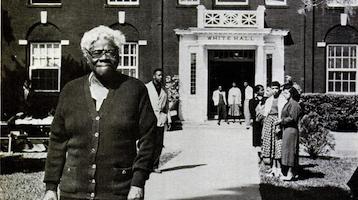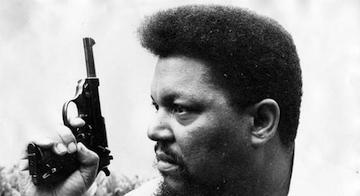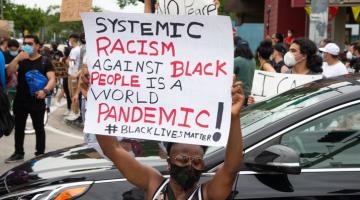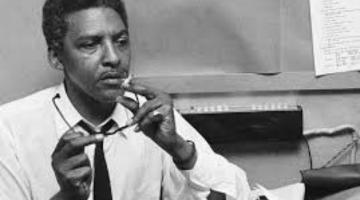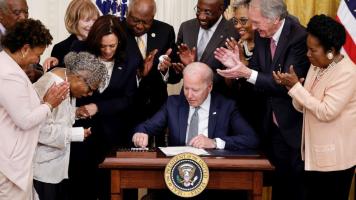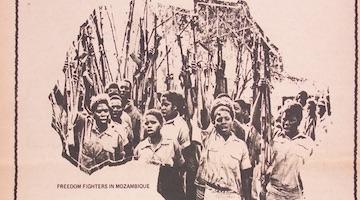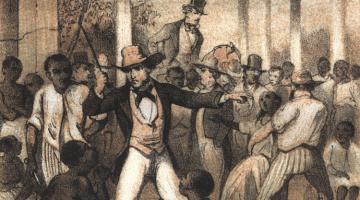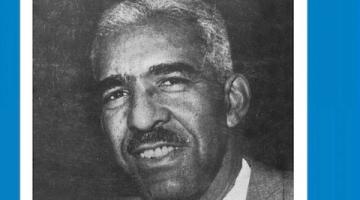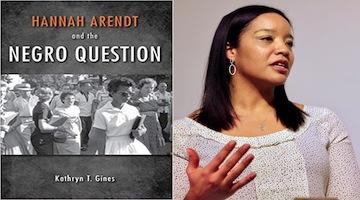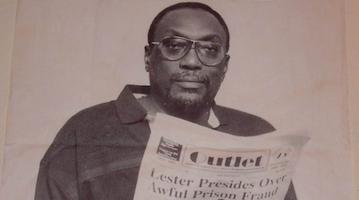Howard Zinn showed that scholarship can fuel solidarity and liberation—but now, some white leftists use it to undermine Black struggle.
Sixty-nine years ago, a 34-year-old Jewish history professor who had used the GI bill to finish his doctoral thesis at Columbia University, trundled his wife, two kids and all their earthly possessions into a 10-year-old Chevy and drove south, to Atlanta, arriving on a hot and rainy August night. The war veteran was not, as he would write later, looking to do good, necessarily, but moved merely for a job. And the best offer he had was for $4,000 annually to chair the social sciences department at Spelman, the historically Black college for women. Of his students, he wrote:
“My students, in a rich variety of colors, had wonderful names like Geneva, Herschelle, Marnesba, Aramintha. They were from all over the country, but most were from the South and had never had a white teacher. They were curious and shy, but the shyness disappeared after we came to know one another. Some were the daughters of the black middle class of teachers, ministers, social workers, small businesspeople, skilled workers. Others were the daughters of maids, porters, laborers, tenant farmers. A college education for these young women was a matter of life and death. One of my students told me one day, ‘My mother says I've got to do well, because I've already got two strikes against me. I'm black and I'm a woman. One more strike and I'm out’...
I soon learned that beneath my students' politeness and decorum there was a lifetime of suppressed indignation. Once I asked them to write down their first memory of race prejudice, and the feelings tumbled out. One told how as a teenager she sat down in the front of a bus next to a white woman. ‘This woman immediately stormed out of her seat, trampling over my legs and feet, and cursing under her breath. Other white passengers began to curse under their breaths. Never had I seen people staring at me as if they hated me. Never had I really experienced being directly rejected as though I were some poisonous, venomous creature.’ A student from Forsyth, Georgia, wrote: ‘I guess if you are from a small Georgia town, as I am, you can say that your first encounter with prejudice was the day you were born. ... My parents never got to see their infant twins alive because the only incubator in the hospital was on the 'white' side..."
The white, Jewish professor had been at Spelman six months when he and his students decided to visit the Georgia state legislature but were confronted with a segregated gallery marked “colored.” Quickly conferring, the group of about 30 students decided to simply ignore the signs and sit in the empty main section, while the legislators debated a bill on fishing rights in Georgia rivers. But as the students took their seats, panic broke out. The Speaker of the House rushed to the microphone and shouted:
“You nigras get over to where you belong! We got segregation in the state of Georgia.”
Deciding that this was not a hill to die on, the students moved to the segregated gallery. But three years later, in 1959, the professor, acting as faculty advisor, proposed that the Spelman Social Science Club move beyond the theoretical and “do something about the segregation of the public libraries?”
And so it came to pass, two years before a series of lunch counter sit-ins sparked a youth movement, that a few young women at Spelman College decided to challenge the main Atlanta library’s racial policy. Methodically, Black students would enter the Carnegie Library, to the stares of everyone around, and ask for John Locke's An Essay Concerning Human Understanding, or John Stuart Mill's On Liberty, or Tom Paine's Common Sense. The professor would later write:
“Turned away with evasive answers (‘We'll send a copy to your Negro branch’), they kept coming back, asking for the Declaration of Independence, the Constitution of the United States, and other choices designed to make sensitive librarians uneasy.”
Weeks into the campaign, the Atlanta library system relented and ended its policy of segregation.
The Spelman professor in question was Howard Zinn, who went on to author A People’s History of the United States, which has sold more than two million copies since it was published in 1980. Among his students were Zoharah Simmons (née Gwen Robinson) who would go on to be a leader for the Student Nonviolent Coordinating Committee and a university professor; the novelist Alice Walker and the child welfare advocate Marian Wright Edelman, who wrote warmly of her relationship with the “tall, lanky” professor.
“We called him Howie and felt him to be a confidant and friend as well as a teacher, contrary to the more formal and hierarchical traditions of many black colleges. He stressed analysis and not memorization; questioning, discussions, and essays rather than multiple choices and pet answers; and he conveyed and affirmed my Daddy's belief and message that I could do and be anything and that life was about far more than bagging a Morehouse man for a husband.”
Zinn died 15 years ago at the age of 87 but his relationship with his students was the template for a brand of pedagogy that urged scholars to exalt the working class rather than lecture it, to learn at least as much as they teach, and to center—rather than gaslight--the unique experiences and political agency of women, African Americans and other racialized groups whose suffering is especially acute under monopoly capitalism. In this way, Zinn was part of a generation of leftist intellectuals that included Herb Aptheker, Phil Foner, Ewart Guinier, Theodore Allen, Noel Ignatiev and others who saw knowledge production as the rebar of social transformation.
But if Zinn’s scholarship was a model for strengthening and expanding democracy, Norman Finkelstein exemplifies its counter, at least in recent years. A political scientist professor who first gained national attention in 2000 with the publication of his groundbreaking book, The Holocaust Industry: Reflections on the Exploitation of Jewish Suffering – which posits that the Zionist project appropriated the murder of six million Jews to extort Western financial support — Finkelstein has focused on producing knowledge that seeks to undermine democracy by denying the pivotal role that a radical Black power movement played in modernizing the U.S. economy and social sphere. And in doing so, he tends to flatten African American intellectuals and activists, reducing them to one-dimensional caricatures. In a recent interview with the podcaster Briahna Joy Gray, he said:
“I think there's just so much illusion about the 60s and these radical groups, you know, like the Black Panthers and this iconization of people like Eldridge Cleaver and Huey Newton and Bobby Seale. They were completely marginal figures. They were, as many people have said, they were basically telegenic figures.
Interrupting, Gray asked if the Panthers were merely telegenic, why were so many assassinated? Finkelstein responded:
“You know, I know the history very well, believe me, because I was part of that era. I was a Black Panther groupy, a complete idiot. Uh I was a Black Panther uh groupy…in the case of Black Panthers it was Fred Hampton, Mark Clark and Bobby Hutton. Three people were assassinated. It wasn't. . . a critical assassination in my opinion.”
He went on to recommend that Gray consult with the former Cleveland Mayor and Congressman Dennis Kucinich to better understand the populist uprising of the 1960s.
Finkelstein’s scholarship is invaluable in understanding Israel’s occupation and genocide in Gaza; his understanding of U.S politics, on the other hand, is stupefying. In virtually everything he asserts to Gray, the opposite is true. For starters, at least three dozen Panthers were slain by the state, key among them Hampton on December 4, 1969. With his eloquent appeals for a rainbow coalition of whites, Blacks, and Latinos to confront the American ruling class, Hampton’s state killing triggered what Michael E. Staub, an English professor at the City University of New York, described as a “moral panic” in the wealthiest 1 percent that continues to reverberate to this day. Frantic to discourage whites from joining a radical Black polity whose message of interracial solidarity and class-consciousness represented an existential threat to white privilege, the legacy news media invented “New Journalism” six months after Hampton’s murder, in the form of Tom Wolfe’s iconic 1970 article in New York Magazine. Entitled Radical Chic: That Party at Lenny’s, and illustrated with a cover photograph of three glamorous white women in evening gowns raising their gloved fists in a Black power salute, Wolfe’s account of a lavish fundraiser for 21 jailed Black Panthers held at the composer Leonard Bernstein’s upper East Side townhouse made no pretense of objectivity in delivering a hissing broadside taking aim at the Black power movement and the white limousine liberals who would support it.
Yet, if Wolfe’s reportage trafficked in innuendo, glib stereotypes and tropes suggesting a libidinal motive to the pairing of Black revolutionaries and white socialites, then Gail Sheehy’s two-part series that appeared in New York magazine five months later went full-on Birth of a Nation. Centered on the trial of 12 Black Panthers for murdering one of their own in New Haven, Connecticut, Sheehy’s article, entitled The Agony of Panthermania, was offered as an interrogation of the relationship between New Haven’s middle-class, or good Blacks, against the “bad n@#$%^” who joined the local Panthers chapter. According to Sheehy, not only were urban blacks addicted to hustling, and often heroin ‘chipping a little . . . under the skin of [the] knee . . . “they were overly sexual, had low IQs, and were overly concerned with cool headgear and fancy cars. Sheehy even mobilized the motif of the emasculated black man "desperate to claim his manhood" fixated entirely on “ego and sex.”
And while New Journalism did combine with the FBI’s counterintelligence program, Richard Nixon’s Southern Strategy and the Reagan revolution to ultimately crush a burgeoning, interracial workers’ movement, the Black Panthers’ broad appeal had indeed set in motion a political force that threatened the state. Bernardine Dohrn, a founder of the radical, white leftist organization, the Weather Underground, wrote six months before Hampton’s assassination:
“The best thing that we can be doing for ourselves, as well as for the Black Panthers and the revolutionary Black liberation struggle, is to build a fucking white revolutionary movement.”
Such expression of interracial solidarity caused David Rockefeller to write in 1971 to his fellow Chase Manhattan board members:
“It is clear to me that the entire structure of our society is being challenged.”
Michael Simmons, a former SNCC member who co-authored the Vine City Paper that urged the organization to expel whites in 1966, told Black Agenda Report that Finkelstein’s interview with Gray helps explain why.
A part of the reasoning of the SNCC faction that urged the expulsion of whites was simply logistical, Simmons said: it would be a more efficient use of resources to have whites organize other whites.
But part of it was that whites in SNCC took up too much space. Antithetical to Zinn’s style of engaging with his students, whites in SNCC would often assert their authority over Blacks in an organization created to address their subjugation. Said Simmons:
“They didn’t see the Black folks as having contributions to make as far as strategy, they didn’t come to SNCC as students, they came there as teachers.”
The purpose of both scholarship and organizing should be to empower people, Simmons said.
“There was a reason we thought white people shouldn’t be involved. It’s not like we didn’t like white people. If I organize a group of women, and they think that I did it, that’s no good. My goal is for them to see that they did it, or can do it without me.
If one day they say to me ‘Mike, we got this, you go on home, there are some things we want to chop up among ourselves,’ then I am happy about that. Mission accomplished. But that ain’t how most of these white folks feel; they want this enduring “Thank you Mr. Charlie.”
The irony is that Simmons met Finkelstein 24 years ago following September 11 when an organization he worked with, the American Friends Service Committee, invited a group of scholars and journalists to Istanbul to urge Turkey to rebuke U.S. entreaties to use their territory as a staging area for the Iraq war.
“Norman and I became friends during that meeting...and one of the things about him that drew me to him was that he was working with this organization of working- class Black women who produced a great film that focused on the role of women in the civil rights movement.”
Simmons said the two stayed in touch initially but lost contact in recent years, but has kept up with him through interviews.
“The Norm I met more than 20 years ago and Norm now…it’s like we’re talking about two different people.”
In his interview with Gray, Finkelstein went on to mischaracterize Martin Luther King Jr.’s relationship with Bayard Rustin, arguing that the primary organizer of the March on Washington distanced himself from the civil rights icon in his final days when the truth is that it was King who distanced himself from Rustin because it was widely suspected that the FBI had coopted Rustin. In this vein, Finkelstein’s scholarship is reminiscent of Hannah Arendt’s who once wrote that African American parents who sought to desegregate public schools were no more than social climbers who wanted simply to keep up with the white Joneses.
I should acknowledge that this is not the first time Finkelstein has crossed my radar. In my 2023 review of I’ll Burn That Bridge When I Get to It! Heretical Thoughts on Identity Politics, Cancel Culture, and Academic Freedom, I describe his book (generously in my opinion) as :
“…a 544-page temper tantrum that is so vulgar, vacuous, inchoate, and graceless that it could just as easily have been written by Tucker Carlson, Bill Maher or Sean Hannity.
As the unimaginative title suggests, I’ll Burn That Bridge When I Get to It! takes aim at the peculiar institution of “wokeness” that in Finkelstein’s estimation undermines class solidarity in the U.S. by pitting the exaggerated grievances of people of color, women and the trans community against the divine rights of straight, white men who are mad as hell, by God, and not going to take it anymore!
Still, Simmons insists that Finkelstein is not necessarily representative of the white American Academy. There are many scholars today carrying on the legacy of intellectuals such as Howard Zinn, who taught his ex-wife and fellow SNCC activist Zoharah Simmons. As one example, he cites Dan Berger, Associate Professor of Comparative Ethnic Studies at the University of Washington at Bothell, who wrote a biography of Simmons and his ex-wife, Stayed on Freedom: The Long History of Black Power Through One Family’s Journey. But the media promote figures such as Finkelstein.
“I think for obvious reasons the media has this investment in telling oppressed people to be cool right now. Norm fits that narrative.”
The difference between Zinn and Finkelstein is approximately the difference between modernity and madness. If Zinn regarded his Black Spelman students as an opportunity to connect, grow and move America forward, Finkelstein sees African American political thought as a rival, challenging his privileged position in society. The cost to the country of marginalizing African Americans is considerable for history is clear: dating back to at least the end of the Civil War, Blacks are the sine qua non of revolution in America.
Jon Jeter is a former foreign correspondent for the Washington Post. He is the author of Flat Broke in the Free Market: How Globalization Fleeced Working People and the co-author of A Day Late and a Dollar Short: Dark Days and Bright Nights in Obama's Postracial America. His work can be found on Patreon as well as Black Republic Media.

